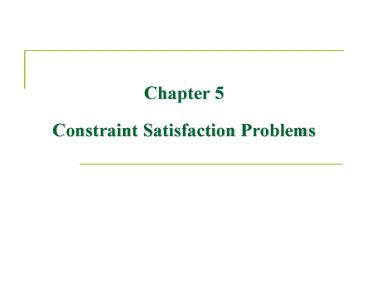Chapter 5 Constraint Satisfaction Problems - PowerPoint PPT Presentation
1 / 28
Title:
Chapter 5 Constraint Satisfaction Problems
Description:
... randomly select any conflicted variable. Value selection by min-conflicts heuristic: choose value ... Iterative min-conflicts is usually effective in practice ... – PowerPoint PPT presentation
Number of Views:73
Avg rating:3.0/5.0
Title: Chapter 5 Constraint Satisfaction Problems
1
Chapter 5 Constraint Satisfaction Problems
2
Outline
- Constraint Satisfaction Problems (CSPs)
representation - Example map-coloring
- Backtracking search for CSPs
- Problem structure and problem decomposition
- Local search for CSPs
3
CSP Representation
- Standard search problems
- state is a black box any old data structure
that supports heuristic function, evaluation
function, and goal test. - Constraint Satisfaction Problems
- a set of variables and a set
of constraints - Each Xi has a domain Di of possible values
- Each Ci specifies allowable combinations of
values for subsets of variables - state is defined by an assignment of values to
some or all of the variables - consistent an assignment that does not violate
any constraints - complete assignment every variable is mentioned
- solution a complete assignment that satisfies
all the constraints
4
Example map-coloring
5
Example map-coloring (contd)
6
Constraint graph
- Binary CSP each constraint relates at most two
variables - Constraint graph nodes are variables, arcs show
constraints
- General-purpose CSP algorithms use graph
structure to speed up search. - e.g., Tasmania is an independent subproblem.
7
Varieties of CSPs
8
Varieties of CSPs (contd)
9
Example cryptarithmetic
10
Real world CSPs
- Assignment problems
- e.g., who teaches what class?
- Timetabling problems
- e.g., which class is offered when and where?
- Transportation scheduling
- Hardware configuration
- Floorplanning
- Many real-world problems involve real-valued
variables
11
Standard search formulation (incremental)
12
Backtracking search
13
Backtracking example
14
Improving backtracking efficiency
- General-purpose methods can give huge gains in
speed - Which variable should be assigned next?
- In what order should its values be tried?
- Can we detect inevitable failure early?
- Can we take advantage of problem structure?
15
Minimum remaining values (MRV)
- MRV
- choose the variable with the fewest legal values
- also called most constrained variable
16
Least constraining value
- Given a variable, choose the lest constraining
value - the one the rules out the fewest values in the
remaining variables - leave the maximum flexibility for subsequent
variable assignments
- Combining these heuristics makes 1000 queens
feasible
17
Forward checking
- Keep track of remaining legal values for
unassigned variables - deletes from its domain any value inconsistent
- terminate search when any variable has no legal
values
18
Constraint propagation
- Forward checking propagates information from
assigned variables, but does not provide early
detection for all failures
- NT and SA cannot both be blue!
- Constraint propagation repeatedly enforces
constraints locally
19
Arc consistency
- Simplest form of propagation makes each arc
consistent
directed arc
20
Problem structure
- Tasmania and mainland are independent subproblems
- Identifiable as connected components of
constraint graph
21
Tree-structured CSPs
22
Algorithm for tree-structured CSPs
23
Nearly tree-structured CSPs
24
Nearly tree-structured CSPs Tree Decomposition
- Every variable in the original problem appears in
at least one of the subproblems. - If two variables are connected by a constraint in
the original problem, they must appear together
(along with the constraint) in at least one of
the subproblems - If a variable appears in two subproblems in the
tree, it must appear in every subproblem along
the path connecting those subproblems. (i.e.,
must have the same value)
25
Iterative algorithms for CSPs
- Hill-climbing, simulated annealing typically work
with complete states, i.e., all variables
assigned - To apply to CSPs
- allow states with unsatisfied constraints
- operators reassign variable values
- Variable selection randomly select any
conflicted variable - Value selection by min-conflicts heuristic
- choose value that violates the fewest constraints
- e.g., hill-climbing with h(n) total number of
violated constraints
26
Example 4-Queens
27
Performance of min-conflicts
28
Summary
- CSPs are a special kind of problem
- states defined by values of a fixed set of
variables - goal test defined by constraints on variable
values - Backtracking depth-first search with one
variable assigned per node - Variable ordering and value selection heuristics
helps significantly - Forward checking prevents assignments that
guarantee later failure - Constraint propagation (e.g., arc consistency)
does additional work to constraint values and
detect inconsistencies - The CSP representation allows analysis of problem
structure - Tree-structured CSPs can be solved in linear time
- Iterative min-conflicts is usually effective in
practice































